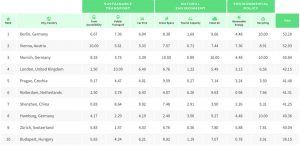Which are the best cities for an eco-friendly getaway? Cities around the world are becoming increasingly eco-conscious in their public policy and travellers are responding. Whether reaching their destination by train or opting for cities outside of the typical tourist circuit, more travellers are choosing to spend their vacations in an environmentally friendly way. Sustainability is changing the way people travel.
Travel company Tourlane have analysed hundreds of cities around the globe to highlight the 50 best cities for eco-friendly getaways.
Cape Town on top
The final shortlist of 50 cities based on eight categories has shown Cape Town as the best city in South Africa for sustainable travel in 2020, and the 41st worldwide.
The German-speaking DACH region ranks particularly highly, with five cities in the top 10. Vienna followed by Munich are this year’s runners up, ranking second and third respectively.
To view the complete list of 50 cities visit the results page here.
“As a carbon-neutral company that offsets the carbon emissions of our travellers and our team, we believe that sustainability is more important than ever when planning trips and travelling” said Tourlane’s Senior Travel Product Manager, Arlett Walleck. “We’re seeing an increasing number of travellers choosing to spend their holidays in an environmentally friendly way and seeking out destinations outside of the typical tourist circuit.
The hot list
Berlin, Germany’s vibrant and cosmopolitan capital city, is the best city for an eco-friendly getaway. If you’d like to do a multi-stop trip, the German cities of Munich and Hamburg also make this year’s top 10.
London is the highest-ranking English speaking city in the ranking, while Shenzhen, China’s green capital, is the top-rated city outside of Europe.
The Norwegian capital, Oslo, is the highest-ranked Scandinavian city in this year’s ranking.
Nairobi is the highest-ranked African destination, and is an excellent place to start a safari trip around Kenya. The green city of Rio de Janeiro places 16th in this year’s ranking, above all other South American cities. Meanwhile, with its excellent public transport and low levels of car ownership, New York City places first in North America.
Melbourne, Australia’s popular and liveable second city, is the best city Down Under for a sustainable vacation.
Europe’s best
If you’re interested in doing a multi-stop tour of the Baltic states, Riga and Helsinki are both placed within this year’s top 25.Copenhagen, Amsterdam, and Warsaw are all also accessible by train in less than a day. The elegant French cities of Paris and Lyon both make this year’s 35. Enjoy both of them with a multi-stop trip—the cities are just two hours apart by high-speed train. Madrid, Spain’s charming and authentic capital city, is also reachable from France by train.
In Asia, the likes of Tokyo, Bangkok, Kuala Lumpur, and Denpasar all make the top 50, although you’ll need to fly between them.
How the guide was produced
Using the following equation Tourlane scaled the data from 1 to 10: Score (i) = 10*(x-minimum)/(maximum/minimum). The following categories are ranked:
Transport
Train Accessibility: This score is based on the number of countries that are reachable by direct train. A higher score equates to a higher number of international connections. International train timetables were used to calculate this score.
Public Transport: This score is based on the length of the metro network and light rail network of each city. A higher score equates to a more extensive metro and light rail network. Data provided by the public transport networks was used to calculate this score.
Car-Free: This score is based on the number of cars per 1000 inhabitants. A higher score equates to a lower number of cars per 1000 inhabitants. A leading online statistics website was used to calculate this score.
Sustainable thinking
Green Space: This score is based on the percentage of the city that is made up of green space. A higher score equates to a higher percentage of green space. A leading online analysis of urban green space based on computer vision and deep learning techniques on satellite images was used to calculate this score.
Tourist Capacity: This score is based on the ratio of local residents to the number of international overnight visitors. Population and visitor data provided by the cities was used to calculate this ratio. A higher score equates to a higher ratio of locals to visitors.
Clean Air: This score is based on the World Air Quality Index. A higher score equates to better air quality.
Renewable Energy: This score is based on the percentage of total energy consumption that comes from renewable energy. A higher score equates to a higher percentage of renewable energy usage. Note that this score is also calculated at a country level as the data is provided by the government, and therefore certain cities have the same score (e.g. Berlin and Munich).
Recycling: This score is based on the percentage of waste that is recycled. A higher score equates to a higher percentage of waste being recycled. Note that this category is also calculated at a country level as the data is provided by the government, and therefore certain cities have the same score.
Read S+L’s Travel Trends for 2020 and we rank The Worlds Top Passports.



